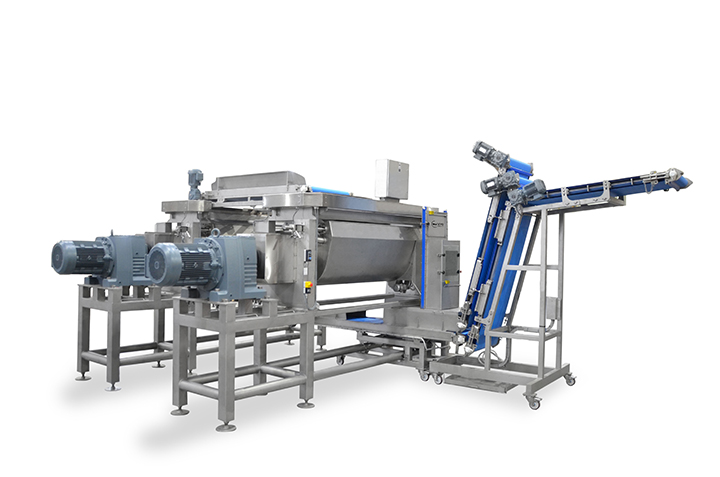
VMI’s VERYMIX kneader is recommended for the continuous production of raw frozen, parbaked and/or pre-proofed and frozen doughs, including baguettes, ciabattas, pizzas, Viennese pastry, puff pastry and flour & water mixtures. Here is how this equipment is built for such an extended range of products.
All types of dough can be processed with the Verymix system, as all the essential parameters are under tight control and optimally combined according to the specific application. Everything can be customized to meet specific production needs thanks to a combination of process para-meters or geometry: shape of the tank, design of the mixing tool, premixing, temperature, speed, up to the atmosphere in the bowl and the energy used. This allows VMI installations the flexibility to cover with this system anything from bread to pastries, and soft products such as sandwich breads and buns. By adapting the tool to increase shearing, the Verymix also becomes very good at kneading crakers too.
When processing colder doughs, a cooling system is necessary. The surface of the dough in contact with the tank needs to be larger, hence the importance of the tool and tank geometry parameters. This also means more energy will be required. “Our Verymix continuous kneader makes it possible to monitor and control energy. From premixing to the end of the mixing process, the viscosity and the formation of the gluten network is monitored thanks to the energy tracking. The cooling system needs, therefore, to be very flexible and very reactive to meet the temperature target, even with a short mixing time,” explains Claire Auffrédou, Marketing and Digital Development at VMI.
Frozen products (and not only) require low manufacturing temperatures, to avoid an ensuing complex cooling process and over-fermentation. The Verymix system can measure the temperature using a probe and display the dough’s temperature before, during, and after mixing on the control panel. “Controlling the temperature makes it possible to manage product development. Enzymes are activated or neutralized depending on the exact temperature level you choose,” she says. This temperature can be automatically regulated by using a double-jacket bowl, in which a cold liquid will circulate. “The traceability and control of the energy transmitted to the dough are part of the developments that control temperature variations. All of our automated kneading systems are equipped with it,” the specialist adds.
Flexibility and consistent results
The Verymix also features weight feeders, an independent pre-mixer, and a rotor-fitted kneader, optimized for continuous workflow throughout the process. It can support a wide range of mixing parameters, thanks to its mixing rotor adapted to the dough, the bowl specifically shaped for continuous mixing operations, adjustable mixing times and intensities. Controlling these parameters supports flexibility for doughs with different characteristics, which is usually not associated with continuous mixing principles. It can control extensive combinations of parameters that enable the bakers to analyze their production: the Verymix provides graphs and visual metering of motor intensity, dough temperature, glycol valve openings, and mixing energy, ensuring stability in production.
Consistent results in dough characteristics begin with accurate material dosing; anything from solid or liquid fats, scrap, specialty flours, to eggs, dried fruits, and particulates can be dosed at any time during the mixing process. Pre-mixing is then essential to producing a homogeneous and smooth dough, which is also continuously measured and verified. The Horizontal PreMixer (HPM) from VMI works directly above the Verymix and always transfers hydrated raw materials into the continuous mixer underneath, where the dough is mixed to the required consistency.
Consistency in production also means that operations are streamlined to avoid losses, variations in output, and to follow exact specifications, all of this at a volume of up to several tons per hour. “This mixing system guarantees a considerable increase in production efficiency. Optimizing cycle times allows machines to run longer and faster, increasing production rates and flexibility for varied recipes,” VMI’s specialist details.

Adjustments and automation
Many adjustments can be made while the mixer is operating. One notable example in continuous optimization is the preventive adjustment of the process, according to the use and data it can collect and analyze. The dosing flow rate can be automatically finetuned, based on experience feedback from previous cycles, for instance.
VMI’s continuous mixer allows 24/7 production. The liquid dosing stations can be connected to a mobile Cleaning in Place (CIP) system. “This minimizes production downtime because of the maximum uniformity of dough consistency and limited intermediate cleaning. The least possible frequency of product change is, of course, a parameter that improves production efficiency,” the specialist tells us. Certain sequences in the workflow contribute to the efficiency of the manufacturing: supplying dough directly to the dough sheeter, for example, or producing the same type of dough for extended periods results in more accurate recipe control, requires less workforce, and provides a better quality of the finished product.
For traceability needs, the Verymix system displays control parameters dynamically and stores them for later consultation. It is possible to view, store, consolidate, export, and analyze the mixer’s consumption. Whether it is the ingredients consumed or the amount of dough produced, it is possible to access information in real-time or in historical form, by timings or by shifts.
The ‘Product Learning’ function enables a single dosing station to manage several ingredients. In this way, recipe parameters can be changed automatically, depending on the ingredient. Automated management also removes the risk of errors and their consequent downtimes. The only action to be performed is changing the ingredient itself, contributing to a faster and more efficient process.


